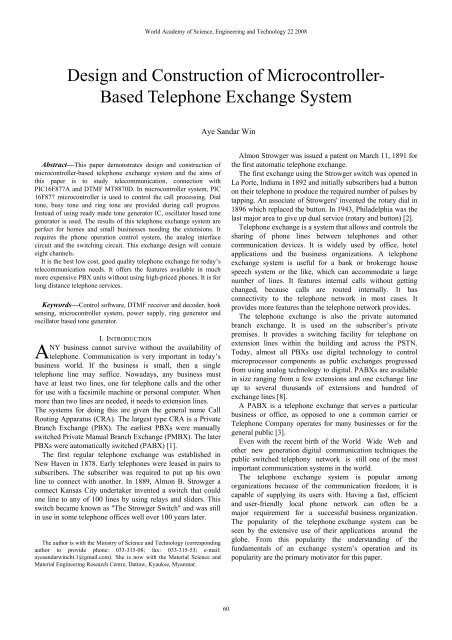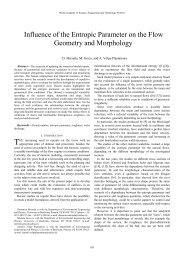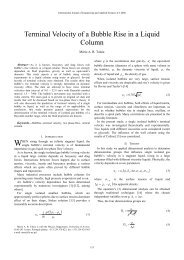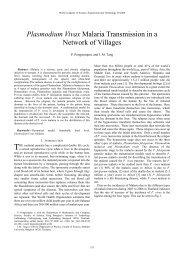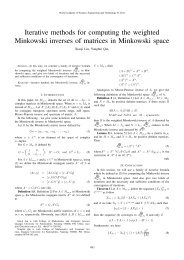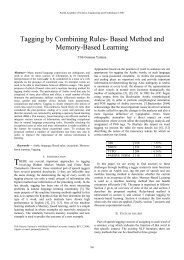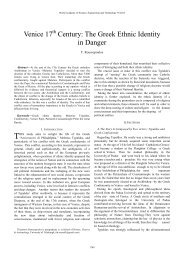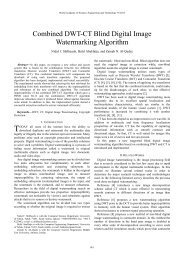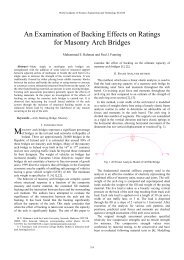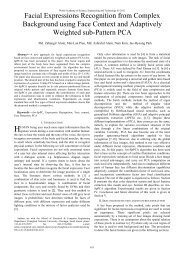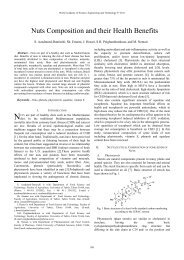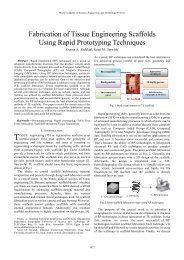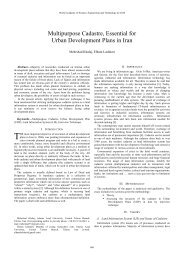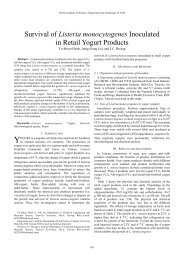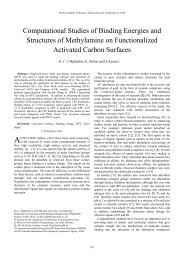Design and Construction of Microcontroller- Based Telephone ...
Design and Construction of Microcontroller- Based Telephone ...
Design and Construction of Microcontroller- Based Telephone ...
Create successful ePaper yourself
Turn your PDF publications into a flip-book with our unique Google optimized e-Paper software.
Abstract—This paper demonstrates design <strong>and</strong> construction <strong>of</strong><br />
microcontroller-based telephone exchange system <strong>and</strong> the aims <strong>of</strong><br />
this paper is to study telecommunication, connection with<br />
PIC16F877A <strong>and</strong> DTMF MT8870D. In microcontroller system, PIC<br />
16F877 microcontroller is used to control the call processing. Dial<br />
tone, busy tone <strong>and</strong> ring tone are provided during call progress.<br />
Instead <strong>of</strong> using ready made tone generator IC, oscillator based tone<br />
generator is used. The results <strong>of</strong> this telephone exchange system are<br />
perfect for homes <strong>and</strong> small businesses needing the extensions. It<br />
requires the phone operation control system, the analog interface<br />
circuit <strong>and</strong> the switching circuit. This exchange design will contain<br />
eight channels.<br />
It is the best low cost, good quality telephone exchange for today’s<br />
telecommunication needs. It <strong>of</strong>fers the features available in much<br />
more expensive PBX units without using high-priced phones. It is for<br />
long distance telephone services.<br />
Keywords—Control s<strong>of</strong>tware, DTMF receiver <strong>and</strong> decoder, hook<br />
sensing, microcontroller system, power supply, ring generator <strong>and</strong><br />
oscillator based tone generator.<br />
A<br />
<strong>Design</strong> <strong>and</strong> <strong>Construction</strong> <strong>of</strong> <strong>Microcontroller</strong>-<br />
<strong>Based</strong> <strong>Telephone</strong> Exchange System<br />
I. INTRODUCTION<br />
NY business cannot survive without the availability <strong>of</strong><br />
telephone. Communication is very important in today’s<br />
business world. If the business is small, then a single<br />
telephone line may suffice. Nowadays, any business must<br />
have at least two lines, one for telephone calls <strong>and</strong> the other<br />
for use with a facsimile machine or personal computer. When<br />
more than two lines are needed, it needs to extension lines.<br />
The systems for doing this are given the general name Call<br />
Routing Apparatus (CRA). The largest type CRA is a Private<br />
Branch Exchange (PBX). The earliest PBXs were manually<br />
switched Private Manual Branch Exchange (PMBX). The later<br />
PBXs were automatically switched (PABX) [1].<br />
The first regular telephone exchange was established in<br />
New Haven in 1878. Early telephones were leased in pairs to<br />
subscribers. The subscriber was required to put up his own<br />
line to connect with another. In 1889, Almon B. Strowger a<br />
connect Kansas City undertaker invented a switch that could<br />
one line to any <strong>of</strong> 100 lines by using relays <strong>and</strong> sliders. This<br />
switch became known as "The Strowger Switch" <strong>and</strong> was still<br />
in use in some telephone <strong>of</strong>fices well over 100 years later.<br />
The author is with the Ministry <strong>of</strong> Science <strong>and</strong> Technology (corresponding<br />
author to provide phone: 033-315-08; fax: 033-315-53; e-mail:<br />
ayes<strong>and</strong>arwincht.1@gmail.com). She is now with the Material Science <strong>and</strong><br />
Material Engineering Research Centre, Dattaw, Kyaukse, Myanmar.<br />
World Academy <strong>of</strong> Science, Engineering <strong>and</strong> Technology 22 2008<br />
Aye S<strong>and</strong>ar Win<br />
60<br />
Almon Strowger was issued a patent on March 11, 1891 for<br />
the first automatic telephone exchange.<br />
The first exchange using the Strowger switch was opened in<br />
La Porte, Indiana in 1892 <strong>and</strong> initially subscribers had a button<br />
on their telephone to produce the required number <strong>of</strong> pulses by<br />
tapping. An associate <strong>of</strong> Strowgers' invented the rotary dial in<br />
1896 which replaced the button. In 1943, Philadelphia was the<br />
last major area to give up dual service (rotary <strong>and</strong> button) [2].<br />
<strong>Telephone</strong> exchange is a system that allows <strong>and</strong> controls the<br />
sharing <strong>of</strong> phone lines between telephones <strong>and</strong> other<br />
communication devices. It is widely used by <strong>of</strong>fice, hotel<br />
applications <strong>and</strong> the business organizations. A telephone<br />
exchange system is useful for a bank or brokerage house<br />
speech system or the like, which can accommodate a large<br />
number <strong>of</strong> lines. It features internal calls without getting<br />
changed, because calls are routed internally. It has<br />
connectivity to the telephone network in most cases. It<br />
provides more features than the telephone network provides.<br />
The telephone exchange is also the private automated<br />
branch exchange. It is used on the subscriber’s private<br />
premises. It provides a switching facility for telephone on<br />
extension lines within the building <strong>and</strong> across the PSTN.<br />
Today, almost all PBXs use digital technology to control<br />
microprocessor components as public exchanges progressed<br />
from using analog technology to digital. PABXs are available<br />
in size ranging from a few extensions <strong>and</strong> one exchange line<br />
up to several thous<strong>and</strong>s <strong>of</strong> extensions <strong>and</strong> hundred <strong>of</strong><br />
exchange lines [8].<br />
A PABX is a telephone exchange that serves a particular<br />
business or <strong>of</strong>fice, as opposed to one a common carrier or<br />
<strong>Telephone</strong> Company operates for many businesses or for the<br />
general public [3].<br />
Even with the recent birth <strong>of</strong> the World Wide Web <strong>and</strong><br />
other new generation digital communication techniques the<br />
public switched telephony network is still one <strong>of</strong> the most<br />
important communication systems in the world.<br />
The telephone exchange system is popular among<br />
organizations because <strong>of</strong> the communication freedom; it is<br />
capable <strong>of</strong> supplying its users with. Having a fast, efficient<br />
<strong>and</strong> user-friendly local phone network can <strong>of</strong>ten be a<br />
major requirement for a successful business organization.<br />
The popularity <strong>of</strong> the telephone exchange system can be<br />
seen by the extensive use <strong>of</strong> their applications around the<br />
globe. From this popularity the underst<strong>and</strong>ing <strong>of</strong> the<br />
fundamentals <strong>of</strong> an exchange system’s operation <strong>and</strong> its<br />
popularity are the primary motivator for this paper.
A. Overview <strong>of</strong> the <strong>Microcontroller</strong>-<strong>Based</strong> <strong>Telephone</strong><br />
Exchange System<br />
This paper demonstrates the eight line telephone systems<br />
with full signaling <strong>and</strong> switching functions similar to those <strong>of</strong><br />
the central <strong>of</strong>fice systems. The eight telephones are connected<br />
to the switching devices <strong>and</strong> common line. In microcontroller<br />
system, PIC16F877A microcontroller is utilized to control<br />
tone control, ring relay <strong>and</strong> on/<strong>of</strong>f-hook switch when the<br />
telephone is used. Tone generator is used to get dial tone, busy<br />
tone, <strong>and</strong> ring tones. Ringing is generated at the receiving end<br />
<strong>of</strong> the phone being called. Ring relay is used to get tone <strong>and</strong><br />
ring processes. DTMF is the basis for voice communication<br />
control. Each number consists <strong>of</strong> a combination <strong>of</strong> two<br />
frequencies. DTMF decoder converts the DTMF tones to the<br />
binary numbers <strong>and</strong> sends to the microcontroller.<br />
In the signaling <strong>and</strong> switching system, transistors <strong>and</strong> relays<br />
are used to switch audio signals <strong>and</strong> control signals <strong>and</strong> to<br />
decode the DTMF signals. These switches are controlled by<br />
powerful s<strong>of</strong>tware procedures to be implemented.<br />
Battery feeds are 24V DC for telephone operation, 90V AC<br />
for ringing <strong>and</strong> 5V DC for microcontroller, DTMF receiver<br />
<strong>and</strong> decoder. DC power supplies are needed mainly to produce<br />
the large voltages required to power the phone during normal<br />
operation.<br />
PIC 16F877A<br />
MICRO<br />
CONTROLLER<br />
TONE<br />
GENERATOR<br />
DTMF<br />
MT8870D<br />
SWITCH<br />
1 TO 8<br />
5V<br />
LINE<br />
90V COMMON<br />
PHONE<br />
NUMBER<br />
1 TO 8<br />
Fig. 1 Block Diagram <strong>of</strong> <strong>Microcontroller</strong>-<strong>Based</strong> <strong>Telephone</strong> Exchange<br />
World Academy <strong>of</strong> Science, Engineering <strong>and</strong> Technology 22 2008<br />
61<br />
Most <strong>of</strong> the telephone exchange systems are implemented<br />
with phone line interface module design. In this paper, line<br />
driver <strong>and</strong> switching circuit will be used which has eight<br />
internal phone lines. The executed programs <strong>of</strong> this paper are<br />
the technical features, the hardware design <strong>and</strong> the control<br />
s<strong>of</strong>tware <strong>of</strong> telephone exchange system.<br />
II. BORSCHT FUNCTIONS<br />
B: Battery - 48V central <strong>of</strong>fice battery supplies DC loop<br />
current (about 40 mA) to energize the voice transmitter <strong>and</strong><br />
the outgoing signal circuit. The battery feed must provide the<br />
following for the local loop:<br />
1. Power (typically 48V DC) to the subscriber’s<br />
telephone set<br />
2. The capability to allow signaling to <strong>and</strong> from the<br />
telephone set<br />
3. Low DC resistance<br />
4. High AC impedance<br />
O: Overvoltage protection - Bypassing or fusing or a<br />
combination to prevent damage from lighting, power line<br />
induction, or accidental power line contact.<br />
R: Ringing -Ringing is <strong>of</strong>ten provided by means <strong>of</strong> a<br />
dedicated ringing generator that is connected onto the loop by<br />
means <strong>of</strong> a relay. It is possible to generate ringing voltages at<br />
the line interface if the current generators have a high enough<br />
voltage source available to them. Or alternately, a switching<br />
converter with step up capability can be place on the interface.<br />
Connection <strong>of</strong> the AC ringing signal to the loop for outgoing<br />
signaling (typically about 90V at 20Hz, interrupted for 4s <strong>of</strong><br />
every 6s).<br />
S: Supervision - Detection <strong>of</strong> loop current to signal<br />
dem<strong>and</strong> for service (or <strong>of</strong>f-book), termination <strong>of</strong> connection<br />
(or on-hook), <strong>and</strong> dial pulsing <strong>of</strong> routing codes for setting up<br />
the switches along the route (or detecting the same as outputs<br />
<strong>of</strong> a multi-frequency Touch Tone signaling unit).<br />
C: Coding / Decoding - Provision <strong>of</strong> the PCM CODEC<br />
functions for connection to a digital switching system (only<br />
provided in recent digital switching machines).<br />
H: Hybrid - Two-wire to four-wire conversion before<br />
connection to a digital switching machine (as for the CODEC<br />
function).<br />
T: Testing - Provision to allow either automatic or<br />
manual testing <strong>of</strong> the subscriber’s loop circuit from the central<br />
<strong>of</strong>fice [7], [9].<br />
This system provides only the BORS functions from the list<br />
above. In this paper, 24V DC is used to communicate in the<br />
surroundings <strong>and</strong> the buildings, <strong>of</strong>fices at most 500 yards<br />
because there is no purpose for long distance. Positive or<br />
negative battery can be chosen because 24V is grounded. It is<br />
compatible for large exchange by using negative battery.<br />
Moreover, only one processor is used because it is enough<br />
for applications. In this circuit two transistors are used as<br />
astable flip flop. Oscillation frequency is used based on RC<br />
timing using charge <strong>and</strong> discharge.<br />
It means that when a design is implemented, optimization is<br />
used depend on intension. There are some differences depend
on the countries which are manufactured the exchanges.<br />
In this paper, 24V DC for telephone operation, 90V AC for<br />
ringing <strong>and</strong> 5V zener voltage regulator for microcontroller,<br />
DTMF, tone generator <strong>and</strong> switching devices. Surge arrestor is<br />
used for overvoltage protection. Ring relay is used for ringing.<br />
Opto-coupler is used for supervision. Surge arrestor or surge<br />
protector is an appliance designed to protect electrical devices<br />
from power surges <strong>and</strong> voltage spikes.<br />
III. HARDWARE DESIGN OF MICROCONTROLLER-BASED<br />
TELEPHONE EXCHANGE<br />
The microcontroller-based telephone exchange system is<br />
designed <strong>and</strong> built by both hardware <strong>and</strong> s<strong>of</strong>tware controlled.<br />
In this system, the main control unit parts are involved as<br />
hardware implementation. The whole reading <strong>and</strong> controlling<br />
is done by PIC s<strong>of</strong>tware.<br />
The telephone exchange uses line driver <strong>and</strong> switching<br />
circuit such as transistors <strong>and</strong> relay. The eight telephones are<br />
connected to the collector <strong>of</strong> the transistors <strong>and</strong> common line.<br />
The LEDs are shown whether the telephone is on-hook or <strong>of</strong>fhook.<br />
The important portions <strong>of</strong> telephone exchange system<br />
are microcontroller <strong>and</strong> dual tone multifrequency. DTMF is<br />
the name for the st<strong>and</strong>ard touch-tone. It is the basis <strong>of</strong> voice<br />
communication control. Each number consists <strong>of</strong> a<br />
combination <strong>of</strong> two frequencies. DTMF decoder converts the<br />
DTMF tones to the binary numbers <strong>and</strong> sends to the<br />
microcontroller. <strong>Microcontroller</strong> knows which key is pressed.<br />
Opto-coupler is sensed for hook sensing. Tone generator is<br />
based on astable multivibrator. Ring relay is used for ringing.<br />
A. Power Supply<br />
In most power supply applications, the st<strong>and</strong>ard 60Hz AC<br />
power line voltage must be converted to a sufficiently constant<br />
DC voltage [6]. In Fig. 2, the output <strong>of</strong> a bridge rectifier must<br />
be filtered to reduce the large voltage variations. The capacitor<br />
filtered the output <strong>of</strong> the bridge rectifier. The filtering concept<br />
showes a nearly smooth DC output voltage from the filter. The<br />
small amount <strong>of</strong> fluctuation in the filter output voltage is<br />
called ripple.<br />
In this paper, there are three kinds <strong>of</strong> power supply: 5V DC<br />
for microcontroller, DTMF <strong>and</strong> switching devices 24V for<br />
telephone operation <strong>and</strong> 90V for ringing.<br />
Fig. 2 Output Voltage <strong>of</strong> a Power Supply<br />
World Academy <strong>of</strong> Science, Engineering <strong>and</strong> Technology 22 2008<br />
62<br />
B. Ripple Voltage<br />
The capacitor quickly charges at the beginning <strong>of</strong> a cycle<br />
<strong>and</strong> slowly discharges after the positive peak (when the diode<br />
is reverse-biased). The variation in the output voltage due to<br />
the charging <strong>and</strong> discharging is called the ripple voltage [4].<br />
C. Pi Low-Pass Filter<br />
Low pass filters using LC components, i.e. inductors <strong>and</strong><br />
capacitors are arranged in either a pi or T network. For the pi<br />
section filter, each section has one series component <strong>and</strong> either<br />
side a component to ground [5].<br />
Transformer steps down high voltage AC mains to low<br />
voltage AC. Rectifier converts AC to DC, but the DC output is<br />
varying. DC is smoothed from varying greatly to a small<br />
ripple. Generally, ripple is undesirable; thus, the smaller the<br />
ripple, the better the filtering action. If the circuit connected to<br />
the power supply takes a lot <strong>of</strong> current, the capacitor will<br />
discharge more quickly <strong>and</strong> there will be a higher ripple<br />
voltage. The more frequent the voltage peaks from the<br />
rectifier, the more <strong>of</strong>ten the capacitor will be charged, <strong>and</strong> the<br />
lower the ripple voltage will be.<br />
Fig. 3 Output Voltage <strong>of</strong> Pi Low-Pass Filter<br />
If the ripple voltage is calculated, this formula can be used.<br />
Vr = Io<br />
(1)<br />
2 fC<br />
where Vr is the ripple voltage in Volts, I is the current taken by<br />
the circuit in Amps, C is the value <strong>of</strong> the smoothing capacitor<br />
in Farads, <strong>and</strong> f is the frequency <strong>of</strong> the peaks from the fullwave<br />
rectifier, in Hertz. This frequency will be double the<br />
normal mains frequency, i.e. 100Hz in the case <strong>of</strong> the UK<br />
mains supply, or 120Hz in the case <strong>of</strong> the US mains supply.<br />
Assume that C = 4700µF, I = 20mA<br />
Vr = 20x10 -3 A/2x50x4700x10 6<br />
= 42mV (approximately 40mV)<br />
The ripple voltage should not be more than 10% <strong>of</strong> Vs - if it<br />
is, increase the value <strong>of</strong> the smoothing capacitor. The larger<br />
the capacitor value, the more charge it can store, <strong>and</strong> the<br />
slower it will discharge. Therefore, smoothing capacitors are<br />
normally electrolytic capacitors with values over 470μF.<br />
4700µF capacitor is the largest <strong>and</strong> 20mA is the smallest<br />
value. Even using these values noise are appeared. As it is
impossible to use more than 4700µF capacitor, pi low-pass<br />
filter is used in this circuit.<br />
Fig. 4 RC Filter Circuit<br />
1<br />
j2∏<br />
fC<br />
vo = vi<br />
∗ [ ]<br />
R+<br />
j2∏<br />
fC<br />
= vi ∗ ( 1<br />
)<br />
1 + j2∏<br />
fCR<br />
o = v ∗ ( 1<br />
) (2)<br />
2<br />
1 + ( 2∏<br />
fCR)<br />
v i<br />
In this equation the more the frequency, the less the output<br />
voltage. DC current is needed but noise frequency is 100 Hz<br />
that is twice <strong>of</strong> the line frequency.<br />
C1 <strong>and</strong> D5 are used because AC for ringing <strong>and</strong> DC for<br />
telephone operation are used together. When AC converts to<br />
DC, ripples are appeared. C1 reduces the output ripples from<br />
the bridge rectifier <strong>and</strong> low pass filter reduces the output<br />
ripples again from C1. This circuit is called pi-filter. R3<br />
(470Ω/1W) limits the current that draws the telephone. D6<br />
protects the circuit from the reverse current. In this paper, R1,<br />
C2 <strong>and</strong> C3 act as a pi low-pass filter, to eliminate harmonics <strong>of</strong><br />
the supply frequency.<br />
D. 5V Zener Diode Regulator<br />
Fig. 5 5V Zener Diode Regulator<br />
A regulator circuit can use to provide a DC voltage that not<br />
only has much less ripple voltage but also remains the same<br />
DC value even if the input DC voltage varies somewhat, or the<br />
load connected to the output DC voltage change. The large<br />
value <strong>of</strong> the capacitor is needed to filter the ripple voltage<br />
according to charging <strong>and</strong> discharging actions. The<br />
unregulated DC voltage is achieved from the capacitor filter<br />
which is regulated to have 5V DC voltage by using zener<br />
diode regulator. 24V DC <strong>and</strong> 90V AC are not regulated.<br />
Because the voltage must be stable for microcontroller .The<br />
supply voltage needs to be between 5.5V <strong>and</strong> 4.5V at most.<br />
The line voltage 220V AC is transformed to 12V. The stepdown<br />
voltage is then applied to the bridge rectifier. In this<br />
World Academy <strong>of</strong> Science, Engineering <strong>and</strong> Technology 22 2008<br />
63<br />
circuit, transformer center tap is kept 12V DC is got because<br />
<strong>of</strong> the bridge rectifier. 12V DC is reduced by using transistor<br />
Q1. Q1 acts as a voltage follower. Q1 base is stabilized by<br />
using 6.2V zener diode. Q1 emitter is 12-6.2 = 5.6V. Zener<br />
diode is used with a transistor because sufficient current is<br />
needed. If only zener diode is used, the current is not enough.<br />
C5 <strong>and</strong> C6 are reduced the output ripples from 12V. Diode D7<br />
protects the transistor from the reverse current that emerges<br />
from logic circuit. 0.6V is reduced <strong>and</strong> the output voltage is<br />
got 5V passing through diode D7. 5V is supplied the<br />
microcontroller 16F877, DTMF MT8870D <strong>and</strong> switching<br />
devices. Using 5V zener diode regulator is cheap.<br />
E. Powering the <strong>Telephone</strong><br />
<strong>Telephone</strong>s require large DC voltages for st<strong>and</strong>ard<br />
operation. When a phone is in the on-hook state (receiver in<br />
cradle) the required voltage is 24V DC. This is said to be<br />
called the idle voltage. When the phone is in the <strong>of</strong>f-hook state<br />
(receiver has been picked up) the required voltage is 12V DC.<br />
When the phone is on-hook no DC current actually flows.<br />
This is because the only circuitry connected to the line is the<br />
ringer circuitry, which includes a capacitor. The capacitor will<br />
only allow AC signals to pass through such as the ringing<br />
signal.<br />
When the phone becomes <strong>of</strong>f-hook the resistance <strong>of</strong> the<br />
whole phone circuitry was found to be 600Ω. Once <strong>of</strong>f-hook,<br />
DC current can now pass through the phone.<br />
Fig. 6 <strong>Telephone</strong>s <strong>and</strong> Switching Circuits<br />
Each telephone is connected in series with the common line<br />
<strong>and</strong> the collector <strong>of</strong> the transistor. <strong>Microcontroller</strong> always<br />
scans which phone is <strong>of</strong>f-hooked by giving high voltage to the<br />
transistors alternately. If one <strong>of</strong> the phones is <strong>of</strong>f-hooked, the<br />
transistor associated with the <strong>of</strong>f-hooked phone will turn on<br />
<strong>and</strong> the collector current flows through the phone line <strong>and</strong> the<br />
common line to the opto-coupler. The opto-coupler is used to<br />
detect hook sensing.
F. <strong>Design</strong> <strong>of</strong> On-Hook/Off-Hook Sensing<br />
In controlling environment must always be aware <strong>of</strong> the<br />
current hook state <strong>of</strong> each telephone. Obviously the phone can<br />
either be in the on or <strong>of</strong>f-hook state. In the hook sensing<br />
design, NEC 2403 opto-coupler is used to sense the line<br />
current. Opto-coupler is designed to provide complete<br />
electrical isolation between an input circuit <strong>and</strong> an output<br />
circuit.<br />
The input circuit <strong>of</strong> an optical coupler is typically an LED,<br />
but the output circuit can take several forms, such as the photo<br />
transistor. When the input voltage forward-biases the LED,<br />
light transmitted to the photo transistor turns it on, producing<br />
current through the external load. When the phone becomes<br />
<strong>of</strong>f-hook, current flows through the opto-coupler causing it to<br />
switch. The switching normally changes an external circuit so<br />
that the phone becoming <strong>of</strong>f-hook can be reported to the<br />
microcontroller.<br />
When the phone is on-hook, no current flows through the<br />
opto-coupler <strong>and</strong> phone circuitry because the capacitor within<br />
the phone’s ringer circuitry blocks DC current. This means<br />
there is no connection in the switching circuitry <strong>and</strong> the value<br />
<strong>of</strong> the hook sensing pin is 5V. When the phone becomes <strong>of</strong>fhook<br />
current will now flow down through the opto-coupler<br />
<strong>and</strong> phone circuitry. The current through the opto-coupler<br />
causes it to switch. Therefore current now flows in the<br />
switching circuitry <strong>and</strong> the value <strong>of</strong> the hook sensing pin will<br />
0V.<br />
Fig. 7 Off-Hook Detector Circuit<br />
The current is applied to the input <strong>of</strong> the opto-coupler, its<br />
LED lights, its light sensor then activates, its transistor is turn<br />
on <strong>and</strong> the output voltage is low. The output voltage goes to<br />
pin 10 (PORT RB1) in the microcontroller. <strong>Microcontroller</strong><br />
always scans until PORT RB1 is low level. If PORT RB1 is<br />
low level, one <strong>of</strong> the phones will <strong>of</strong>f-hook. Then<br />
microcontroller stops scanning <strong>and</strong> give high level to tone<br />
control pin 16 (PORT RB4). C9 is used for not letting DC to<br />
pass through opto-coupler, R23 is shut resistor <strong>and</strong> R22 is used<br />
to limit the current passing through opto-coupler LED <strong>and</strong> one<br />
reverse connected diode in parallel with opto-coupler LED to<br />
prevent negative voltages from damaging the LED.<br />
World Academy <strong>of</strong> Science, Engineering <strong>and</strong> Technology 22 2008<br />
64<br />
G. Tone Generator<br />
The proper name for this circuit is "astable multivibrator". It<br />
is a simple, free - running oscillator circuit timed by the sizes<br />
<strong>of</strong> the resistors, capacitors, <strong>and</strong> power supply voltage.<br />
Unfortunately, its output waveform is much distorted. For the<br />
simple purpose <strong>of</strong> making an audio tone, however, distortion<br />
doesn't matter much. With a 5V supply <strong>and</strong> 22nF capacitors,<br />
the oscillation frequency will be in the low audio range. This<br />
signal is amplified by the amplifier. The multivibrator itself is<br />
just two transistors, two resistors, <strong>and</strong> two cross-connecting<br />
capacitors.<br />
When pin 16 is high, two transistors Q11 <strong>and</strong> Q12 get supply<br />
voltage. Two transistors are used as astable flip flop. Two<br />
capacitors C17 <strong>and</strong> C18 are feedback each other. So two<br />
transistors turn on alternately. Oscillation frequency is got<br />
based on RC timing due to the charging <strong>and</strong> discharging. The<br />
output frequency is amplified by amplifier. R50 <strong>and</strong> Q10<br />
(MA42) act as an amplifier. The amplified frequency is<br />
produced via tone line through relay to the common line. Then<br />
the auto dialing tone is heard in <strong>of</strong>f-hooked phone <strong>and</strong> key is<br />
pressed.<br />
Fig. 8 Astable Multivibrator Tone Generator<br />
H. Ring Generation<br />
A ring generation system needs to be present on telephone<br />
exchange. Ring relay is connected to the tone line <strong>and</strong> ring<br />
line. More commonly the ring signal is at about 25 Hz <strong>and</strong><br />
around 90 V. This AC ring signal is then superimposed onto<br />
the 24V DC required when the phone is in the on-hook state.<br />
The ring signal circuitry has been designed a technique needs<br />
to be implemented so that the ring signal can be cadenced. The<br />
technique used to achieve this based around one relay. The<br />
relay controls when the ring signal is cadenced, by connecting<br />
24V DC for tone <strong>and</strong> 90V AC for ringing.
I. Generation <strong>of</strong> Progress Tones<br />
A Telephony network needs a system whereby users can be<br />
informed <strong>of</strong> the current state <strong>of</strong> their telephone. Signals such<br />
as dial tones, ring tones <strong>and</strong> busy tones do just this. Without<br />
these signals the user can be left wondering if the network is<br />
even responding to their requests.<br />
J. DTMF Detection<br />
DTMF deals with interpreting which buttons on the<br />
telephone the user presses. When a button is pressed on a<br />
phone, a signal representing that button can be transmitted.<br />
This design will be based around only interpreting DTMF<br />
tones. The telephone exchange system needs is a DTMF<br />
detection system.<br />
The circuit connects to the phone’s audio line via a<br />
capacitor, which is used to block any DC current from going<br />
to the DTMF receiver IC. The DTMF tone was received. The<br />
circuit when tested was able to detect all DTMF tones <strong>and</strong><br />
h<strong>and</strong>le a tone separation as small as 90 ms.<br />
When a button is pressed on a phone, key frequency passes<br />
through C10 <strong>and</strong> R24 to DTMF. The input tone signal is<br />
decoded by the DTMF decoder <strong>and</strong> the decoded number can<br />
be read by the PIC at D0-D3 output pins. There is no tone<br />
signal, the output is ‘0’. If key ‘1’ is pressed, the output is<br />
‘0001’. PIC microcontroller knows which number is pressed<br />
by scanning the output from DTMF decoder.<br />
Fig. 9 Connection between <strong>Microcontroller</strong> System <strong>and</strong> DTMF<br />
K. The <strong>Microcontroller</strong><br />
Pin diagram <strong>of</strong> microcontroller system is as shown in<br />
Figure 10. The PIC16F877 microcontroller is used to control<br />
the overhaul system. Oscillator can be 4M Hz crystal <strong>and</strong><br />
either two 15pF capacitors or the ceramic resonator <strong>of</strong> the<br />
same frequency (ceramic resonator already contains the<br />
mentioned capacitors, but unlike oscillator has three<br />
termination instead <strong>of</strong> only two). The rate, at which the<br />
program runs, depends heavily on the oscillator frequency.<br />
The 4MHz crystal <strong>and</strong> capacitors connected to Pins 13 <strong>and</strong> 14<br />
<strong>of</strong> the 16F877A produce the clock pulses that are required to<br />
step the microcontroller through the program an provide the<br />
timing pulses. The most common power supply connecting for<br />
the controller is 5V zener diode voltage regulator.<br />
PORTA is configured to interface with DTMF receiver. The<br />
incoming frequencies are decoded by DTMF <strong>and</strong> appear at<br />
World Academy <strong>of</strong> Science, Engineering <strong>and</strong> Technology 22 2008<br />
65<br />
RA0:RA3. The microcontroller needs to send DTMF tones to<br />
the telephone line. RA0:RA3 read or write binary number<br />
while decoding tones. RB1 bit is configured as input pin from<br />
on-hook <strong>and</strong> <strong>of</strong>f-hook the phone line. The microcontroller uses<br />
RB0 bit to scan 25HZ ringing signal. RB2 is used to control<br />
the ring relay. The common line <strong>of</strong> relay contacts relay pin 4,<br />
ring tone can be heard. RB4 is utilized to control the tone<br />
generator. PORT C is just used to know which phone is using<br />
with LED signals. PORT D is used to sense the eight phones.<br />
IV. SOFTWARE OF THE SYSTEM<br />
The firmware program for the microcontroller is compiled<br />
with the CCSC Compiler Tool suite version 8.02 from HI-<br />
TECH S<strong>of</strong>tware. The source code is written in the MPLAB<br />
IDE version 7.5 from Microchip Corporation.<br />
Fig. 10 Pin Diagram <strong>of</strong> <strong>Microcontroller</strong> System<br />
The operation <strong>of</strong> the phone is broken down into seven states<br />
based around what part <strong>of</strong> the communication process the<br />
phone is currently in. A particular state is the "Off Hook –<br />
Dial" state. This state requires the audio circuitry to be<br />
switched to the phone <strong>and</strong> a dial tone to be generated. If a<br />
phone needs to be put into this state, the microcontroller<br />
knows signaling it to fulfill these requirements. Table I below<br />
lists all telephone states <strong>and</strong> describes what the requirements<br />
are for each.<br />
The state chart allows the user to see which states the user<br />
can move to from a particular state. It is track the operation <strong>of</strong><br />
the telephone exchange by seeing Fig. 11.
V. IMPLEMENTATION OF STATE CONTROL SYSTEM<br />
Firstly, when the telephone is <strong>of</strong>f-hook, a signal is sent to<br />
the microcontroller which the microcontroller underst<strong>and</strong>s to<br />
receive the phone number <strong>and</strong> the first digit is dialed. The first<br />
digit is internal code (*). When the code is dialed, the<br />
microcontroller knows whether the code is correct or wrong. It<br />
begins the routing process. If internal key (*) is received, the<br />
number the user want to call is entered. When the number is<br />
correct, the call progress starts. If there is invalid code or<br />
invalid phone number or idle called phone or self call, busy<br />
tone will be heard. In call progress state, there are four sub<br />
states: tone wait, tone generate, ring wait <strong>and</strong> ring generate. If<br />
the called phone is <strong>of</strong>f-hook, success state begins. If the caller<br />
phone is on-hook in any state, the state must be idled <strong>and</strong> if<br />
the time is out, the busy tone will be heard.<br />
TABLE I<br />
PHONE STATE REQUIREMENTS<br />
State<br />
Phone<br />
Connection<br />
Ring Generated Tone Generation<br />
On Hook Ring Circuitry No No Tone<br />
On Hook -<br />
Ringing<br />
Ring Circuitry Yes No Tone<br />
Off Hook Audio Circuitry No No Tone<br />
Off Hook-<br />
Dial<br />
Audio Circuitry No Dial Tone<br />
Off Hook-<br />
Busy<br />
Audio Circuitry No Busy Tone<br />
Off Hook-<br />
Ring<br />
Audio Circuitry No Ring Tone<br />
Off Hook-<br />
Connect<br />
Audio Circuitry No No Tone<br />
VI. CONCLUSION<br />
The design concept for the microcontroller-based telephone<br />
exchange system has been defined.<br />
The telephone exchange system demonstrates call switching<br />
concepts. In this paper, 220V transformer steps down to 90V,<br />
50Hz. It is not a st<strong>and</strong>ard design but useful. 24V DC is<br />
employed for telephone operation because telephone<br />
exchanges are used only for the surroundings, buildings <strong>and</strong><br />
<strong>of</strong>fices within 500 yards <strong>and</strong> 24V DC is for low power<br />
consumption. But 48V DC can be used for long distance. 5V<br />
zener diode voltage regulator is applied because it is enough to<br />
operate <strong>and</strong> the required current is not more than 1A.<br />
Instead <strong>of</strong> using ready made tone generator IC, oscillator<br />
based tone generator is used. Hence, there is no need to spend<br />
the foreign exchange. Continuous tone is dial tone, discrete<br />
tone (2 second on/<strong>of</strong>f alternatively) is call progress tone or<br />
ring tone <strong>and</strong> fast tone (0.5 second on/ <strong>of</strong>f alternatively) is<br />
busy tone. If tone generator IC can easily be got, there will be<br />
more functions to operate. Although only human can<br />
underst<strong>and</strong> these tones, it is not convenient for the machine.<br />
Only one processor is used for all functions because there is<br />
no much function. Hybrid is not used but common line <strong>and</strong><br />
ground line are employed because there is no switch matrix.<br />
This circuit is a kind <strong>of</strong> non-extensible exchange that is<br />
compact <strong>and</strong> low cost. A pair <strong>of</strong> telephones is used at the same<br />
World Academy <strong>of</strong> Science, Engineering <strong>and</strong> Technology 22 2008<br />
66<br />
time because only one common line is used. If two pairs are<br />
used, two common lines must be used.<br />
Fig. 11 State Chart <strong>of</strong> the Control Program<br />
ACKNOWLEDGEMENT<br />
We would like to thank U Kyaw Zwa Soe, U Aung Aung<br />
Thein <strong>and</strong> Dr. Win Aye for their comments on the early drafts<br />
<strong>of</strong> this paper. We would also like to thank the referees for their<br />
help in improving the clarity <strong>of</strong> the presentation.<br />
REFERENCES<br />
[1] http://www.innovexpo.itee.uq.edu.au/2001/projects/s369342/poster.pdf<br />
[2] http://www.nps.gov/nhl/DOE_dedesignations/<strong>Telephone</strong>.htm<br />
[3] http://en.wikipedia.org/wiki/Private_branch_exchange#PBX_functions<br />
[4] http://www.mitedu.freeserve.co.uk/<strong>Design</strong>/dcpsu.htm<br />
[5] http://www.radio-electronics.com/info/circuits/lc_lowpassfilter/<br />
lc_lpf.php<br />
[6] http://en.wikipedia.org/wiki/ powersupply<br />
[7] http://en.wikibooks.org/wiki/Communication_Systems/<strong>Telephone</strong>_Syste<br />
m<br />
[8] R.Blake. “The <strong>Telephone</strong> System. Comprehensive Electronic<br />
Communication”, 1997, pp. 325-344.<br />
[9] S.J.Bigelow, J.J. Carr, S.Winder, “Underst<strong>and</strong>ing <strong>Telephone</strong><br />
Electronics,” Fourth Edition, Butterworth-Heinemann, 2001.


